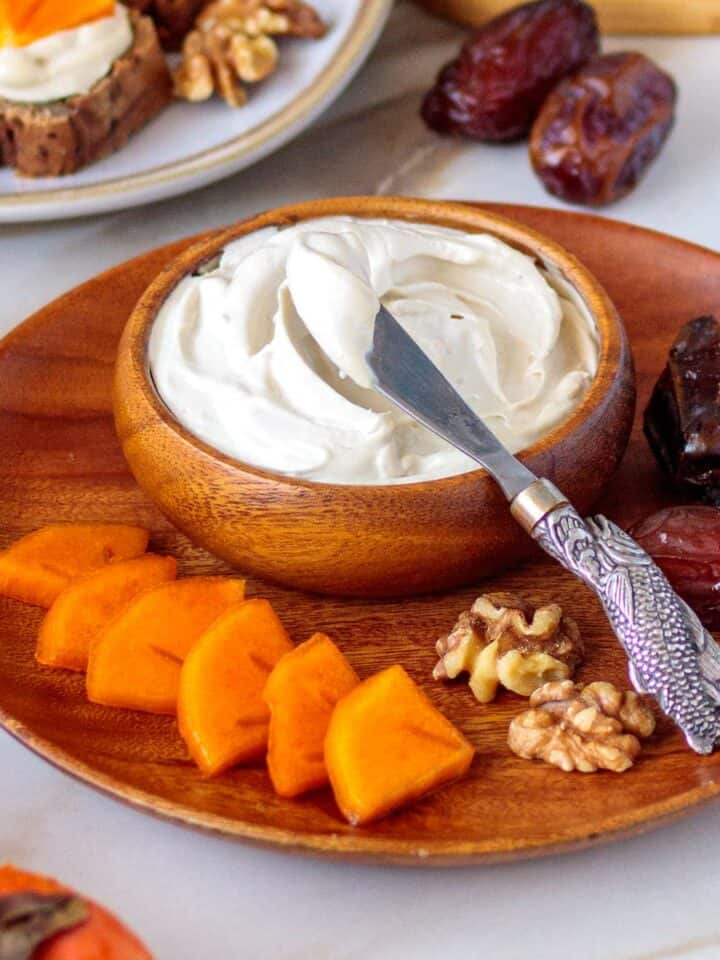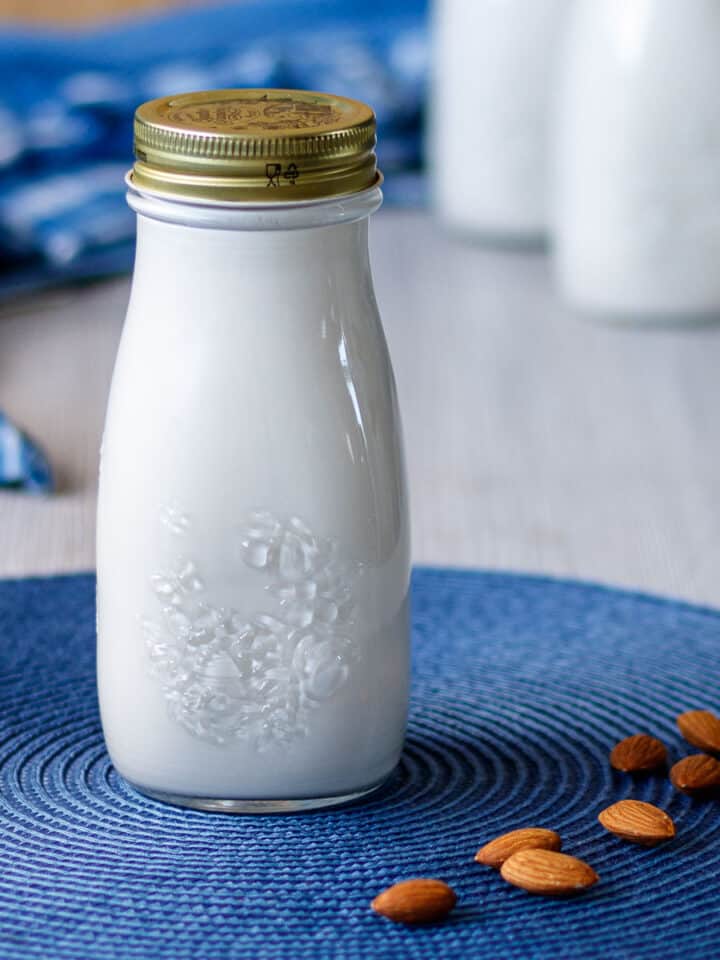Did you know it's possible to make an all-natural, vegan ghee substitute at home with coconut oil, macadamia nuts, and aromatics? Its buttery, nutty taste is irresistible, and you can cook and season with it just like regular ghee.

Jump to:
🏆 Top tip
Browning macadamia nuts in coconut oil gives vegan ghee an extra layer of toastiness.

⭐ Why it works
- All-natural whole foods and cholesterol-free coconut oil. No artificial additives or GMOs.
- Dairy-free with no lactose, casein, gluten, or soy.
- High smoke point for use in frying and sauteing.
- Superior taste - recipe perfected for a delicious toasty, buttery flavor.
- Consistency similar to traditional ghee. Spreads when cool and pours when warm.
- Versatile - ideal for Indian cuisine and great as a spread, drizzled over popcorn or in savory bakes.
- Stores well without refrigeration.
📋 Ingredients

- Coconut oil - Refined, neutral-tasting, unscented coconut oil is essential for the best ghee substitute. Nutiva has organic, steam-processed Fair Trade coconut oil.
- Guava leaves - I prefer fresh, but you can use dry as well. MyIslandJamaica, sells wild-crafted, organic guava leaves.
- Curry leaves - have complex subtle flavors that complement Indian food and many other recipes as well. Angkor Food has fresh organic curry leaves.
- Macadamia nuts - raw macadamia nuts are a key ingredient in ghee substitute.
- Turmeric root - for color. I like to use fresh raw turmeric, but you can substitute dry turmeric powder with good results.
- Himalayan pink salt - mineral rich and so tasty. Salt is optional.
🔪 Steps

- Toast macadamia nuts until edges are golden.
- Finish browning nuts with sliced turmeric in a small amount of coconut oil.
- Steep guava and curry leaves with macadamia nuts and turmeric in the remaining oil.
- Strain ghee after 30 minutes.
🥄 Why make vegan ghee substitute?

Vegan ghee is a plant-based alternative to traditional cow ghee and, thus, a great substitute if you want to avoid lactose, cholesterol, and the casein in animal products.
It provides all the rich mouthfeel one craves with melted butter and a remarkably similar flavor. I confess, when I have a jar in the cupboard, I have to watch that I don't indulge in this liquid gold too often!
It's indispensable to the vegan cook when frying Indian spices to make tadka or give authenticity to dishes like Instant Pot Sambar, Green Onion Pulao, and Chana Dal With Spinach.
🧈 Ghee vs. Butter
Not only does ghee have an addictive, unique taste that butter doesn't, it also has a longer shelf life and advantages in the kitchen for a home chef.
For example, Master Class illustrates the importance and differences of smoking point when cooking with fats. You'll be happy to know that this vegan ghee substitute has a much higher smoke point than butter.
🌰 Macadamia nuts

When ghee is made from cow's milk, the milk solids separate, settle to the bottom of the pan, and brown as they continue to cook. These crumbly bits are what give ghee the distinct flavor that simple melted or clarified butter doesn't have.
With vegan ghee made from plant oils, you need other ways to get that delicious roasty flavor. That's where macadamia nuts come in.
While guava leaves do impart a flavor subtly reminiscent of ghee, I find boosting it with toasted macadamia nuts produces a brand-new buttery spread that is a much more satisfying ghee substitute.
🌿 Guava leaves and curry leaves

It's really quite wonderful how guava leaves and curry leaves work with turmeric and toasted macadamia nuts to transform clean, neutral coconut oil into the marvel of vegan ghee.
You can pick them right off the tree if you are fortunate to have them nearby. We keep a supply of guava leaves on hand to make our healthy and refreshing Guava Leaf Tea.
Your best sources if you need to purchase them are health food stores, herbal stores, Asian markets, and online.
My Island Jamaica supplies wild-crafted guava leaves, and you can get organic curry leaves from Angkor Food. If you're wondering whether to use fresh or dry, I ran a little experiment for you.
🍂 Fresh or dry?

I steeped both versions of each in hot coconut oil to see which would infuse more flavor into a vegan ghee substitute. The good news is all four variations will work.
I did have a taste preference and interestingly settled on a combination of fresh guava leaves and dry curry leaves. I wonder if these subtleties matter to you and what your preference would be!
Here is how my tastebuds assessed the nuances:
- Fresh guava leaves - nutty, toasty, and pronounced.
- Dry guava leaves - nutty with a slightly tannic aftertaste.
- Fresh curry leaves - pleasantly complex, with light green herbal notes.
- Dry curry leaves - the most aromatic, with a palette of deep flavors.
👩🏻🍳 Expert tips

- Slice fresh turmeric thin or sub dry powdered turmeric to achieve the desired color.
- Chop macadamia nuts coarsely into ¼-inch to ½-inch pieces, so they don't burn.
- Divide coconut oil - use a small portion to fry macadamia nuts and turmeric first, then add the remaining oil when steeping guava and curry leaves.
- Roast macadamia nuts in oil with turmeric until they are a deep golden color but take care not to burn them. They will continue to cook in the next step.
- Heat remaining coconut oil to a quick boil, add the macadamias and turmeric with their oil, the guava and curry leaves, and promptly remove from heat.
- Steep leaves in coconut oil for 30 minutes for the best taste. Steeping too long can create astringent flavors.
- Strain vegan ghee into a pitcher or glass measuring cup with a spout for easy pouring.
- Store at room temperature in glass or ceramic containers.
- Pour or spread ghee as you like. It will remain liquid in warm climates and firm up in cool climates. You can set your jar of vegan ghee in a bowl of hot water or place it in the refrigerator briefly to adjust the consistency.
💭 Faq

The results will vary with the brand and ingredients in vegan butter from the store. Traditional ghee is made by simmering butter until the pure butter fat and milk solids separate and a toasty flavor develops from the browned milk solids. Cooking and straining vegan butter made primarily from plant oils and emulsifiers may not develop a similar enough flavor or consistency to make a satisfying ghee substitute.
No, ghee is not dairy-free. While cooking butter and straining it into ghee reduces the amount of milk solids and lactose present, it is still made from milk, a dairy product.
No. Despite the name, curry leaves don't taste like curry powder. Curry leaves have a unique flavor that is hard to convey, but it's often described as nutty, citrusy, or slightly bitter. The leaves are also highly aromatic with a warm, complex perfume.
🥛 More vegan dairy alternatives
Enjoyed this post? Leave a comment, rate ⭐⭐⭐⭐⭐ it, and follow @poppyswildkitchen on Instagram. Aloha!
📖 Recipe

How To Make Vegan Ghee Substitute
Ingredients
- 2 TB macadamia nuts coarsely chopped
- 2 TB thinly sliced turmeric root or substitute turmeric powder
- 8 dried curry leaves
- 4 fresh guava leaves 3-4 inch size, torn
- ¼ tsp. Himalayan pink salt optional
- ½ cup coconut oil refined, unscented
- 1 ½ cups coconut oil refined, unscented
Instructions
Make ghee substitute
- Toast 2 TB macadamia nuts in a dry skillet over medium-high heat until the edges are light golden brown. Stir them constantly, and don't let them burn. They will cook further in the next recipe steps.
- Add ½ cup coconut oil, 2 TB thinly sliced turmeric root and optional ¼ tsp. Himalayan pink salt. Cook until the nuts are fully golden brown, about 5 minutes.
- Add the remaining 1 ½ cups coconut oil with 4 fresh guava leaves and 8 dried curry leaves. Bring to a boil, remove from heat, and let the mixture steep for one hour.
- Line a wire mesh strainer with a thin cloth and place it over a small pitcher or glass measuring cup with a pour spout. Pour the vegan ghee mixture into the cloth and let it strain through.
Store
- Let the ghee substitute cool slightly and transfer it to glass containers. Store at room temperature for 3 months or freeze for 6 months.













"Share Your Thoughts"